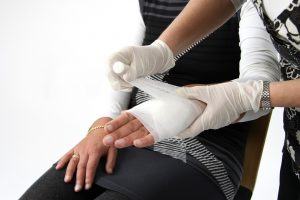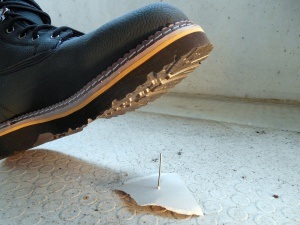Need Immediate help? Call 717-397-1010
After Hours Call / Text 717-471-2168
Need Immediate help? Call 717-397-1010
After Hours Call / Text 717-471-2168
 There are a lot of benefits of holding a proper Workers’ Compensation insurance policy as a company from having medical bills and at least some lost wages covered when an employee is injured at work. However, with that coverage also comes the risk of abuse by unscrupulous employees looking to rig the system. The first step to working against such abuse is to understand the types of fraud that commonly occur.
There are a lot of benefits of holding a proper Workers’ Compensation insurance policy as a company from having medical bills and at least some lost wages covered when an employee is injured at work. However, with that coverage also comes the risk of abuse by unscrupulous employees looking to rig the system. The first step to working against such abuse is to understand the types of fraud that commonly occur.
Fraud can happen at any point in the claim process, from the injury itself to claims made about the severity of the injury. Here are some common forms of fraud to look out for:
The first step in preventing fraud in Workers’ Compensation claims is to have a very clearly written company policy on Workers’ Compensation for all employees. This policy will help aboveboard employees understand the process while providing an avenue in which to inform underhanded employees that investigations and legal action will be taken to avoid cases of fraud. In that policy, be sure to let your employees know that there is an immediate need to report injuries and accidents, and that there will be no negative consequence for doing so.
Further, be sure to follow up and conduct investigations into claims. This is to ensure all aspects are accurate and are being handled, which will aid those using the system properly for those with a legitimate injury while making it more difficult for those attempting fraud. If you have been accused of fraud for a legitimate injury, you need legal representation. Contact our team today for more information.
 If you have been injured at work, it makes sense to hire a lawyer as soon as possible to ensure you get the compensation to which you are entitled. However, what should one expect when they decide to call a work injury lawyer? Understanding the information a lawyer needs before making the call can lead to a better consultation and get more out of the typically free service law firms offer to their potential clients.
If you have been injured at work, it makes sense to hire a lawyer as soon as possible to ensure you get the compensation to which you are entitled. However, what should one expect when they decide to call a work injury lawyer? Understanding the information a lawyer needs before making the call can lead to a better consultation and get more out of the typically free service law firms offer to their potential clients.
The first thing a lawyer will need is your employment information. This includes:
The amount of benefits offered to workers largely depends on the average weekly pay of a worker. Further, the marital status and number of children under the age of 18 can have an impact on a claim award. Have this information ready prior to calling a lawyer for the best idea of how successful your claim will be and what you can expect out of an award.
The accident itself can have an impact on what can be recovered in terms of compensation after an injury. Relevant information includes:
History of medical treatment has a bearing on how the claim will proceed. This information includes:
Above is the minimal information a person should have on hand when contacting a lawyer. Having correspondence with the employer or insurance company such as if you have received weekly benefits, how medical care was paid for, outstanding medical bills, contact information of any insurance agents spoken to, and any offers that have already been made on the claim are helpful when applicable to the situation. Further, any information from before the accident such as previous injuries and illness or previous Workers’ Compensation or personal injury claims can be helpful.
The next step is finding the right lawyer for your case. Contact our team today for a free consultation on your claim.
 When a worker is injured on the job, it’s difficult to be critical since they are in pain. However, having a drug test after a work injury can be crucial. While Workers’ Compensation is a no-fault system, a worker that was under the influence will not be eligible for the same benefits as an employee that was exercising proper behavior. In fact, a drug test could prevent a worker from collecting benefits at all.
When a worker is injured on the job, it’s difficult to be critical since they are in pain. However, having a drug test after a work injury can be crucial. While Workers’ Compensation is a no-fault system, a worker that was under the influence will not be eligible for the same benefits as an employee that was exercising proper behavior. In fact, a drug test could prevent a worker from collecting benefits at all.
Drug testing an employee is not always legal. This is because they are owed a certain amount of privacy. However, when an injury becomes involved, the legal stance changes a bit. In many cases, there is good reason to be suspicious, which is when it is legal to drug test an employee normally. In most cases, it can be difficult to prove there was good reason to be suspicious but having an accident that could have been avoided is one of the best ways to justify why an employee should be tested.
However, there should still be caution expressed, as illegally testing an employee will only cause worse issues when it comes to the work injury.
Hopefully, as an employer, you have considered the possibility of an injured worker prior to its happening. Additionally, it should be a consideration of how it will be handled if an intoxicated person comes to work even if they are not injured. The best thing a company can do is write a drug testing policy in their employee handbook, outlining the reasoning for drug testing and having employees sign an acknowledgment of your policies.
A drug test should happen as soon as possible after an injury. The quicker the test, the more accurate the results. After all, many drugs, such as alcohol, quickly dissipate and are difficult to prove. However, showing the person was above the acceptable BAC percentage an hour after the injury will be good evidence against the claim.
If you use a lab that is not reputable, it will be argued during the claim. Don’t count on the employee not having legal representation, as many immediately seek a lawyer after being injured on the job.
Regardless of the results of the test or if you are able to demand a test, medical care should be given as soon as possible. Even if the employee was heavily intoxicated, you still have a duty of care in ensuring they receive medical attention when necessary.
If you have been injured at work and your employer is trying to use evidence of intoxication against you, contact our team today. We understand both sides of defense and will use our experience to benefit you.
 As desk jobs become more popular as a type of occupation, injuries related to such jobs are increasing. It may sound unlikely an injury would incur while sitting behind a desk but sitting all day can have a negative impact on the body, especially considering approximately 80% of workers today work in a role that involves little or no physical activity. Straining the arms or sitting without proper support, along with fast typing, puts workers at a higher risk of injury than most consider.
As desk jobs become more popular as a type of occupation, injuries related to such jobs are increasing. It may sound unlikely an injury would incur while sitting behind a desk but sitting all day can have a negative impact on the body, especially considering approximately 80% of workers today work in a role that involves little or no physical activity. Straining the arms or sitting without proper support, along with fast typing, puts workers at a higher risk of injury than most consider.
Further, desk jobs heighten some risks for repetitive injuries. For instance, someone may develop carpal tunnel or other wrist-related injuries by continually using a keyboard every day, particularly if the keyboard is not ergonomic. While these types of injuries are not always avoidable, particularly when you have a predisposition toward development of certain conditions, there are some tips that can make your work environment much more comfortable.
If you are beginning to feel the first signs of a work injury, or are concerned about aches and pains you have been feeling, consider the following tips to help take care of yourself at work.
If you already are seeing the signs of a work injury, contact our team today for a free consultation on your claim.
 When you are injured at work, it can be a time of many emotions. First, there is concern over your health and safety. But second, there is concern over what this means for your job and what actions need to be taken following an injury that happens in the workplace. While each state has its own regulations on how things are handled, and each company has its own set of policies, there are steps that can be taken in any jurisdiction or company following an accident.
When you are injured at work, it can be a time of many emotions. First, there is concern over your health and safety. But second, there is concern over what this means for your job and what actions need to be taken following an injury that happens in the workplace. While each state has its own regulations on how things are handled, and each company has its own set of policies, there are steps that can be taken in any jurisdiction or company following an accident.
Following a work injury, take the following precautions to ensure your rights are protected:
If you have been injured on the job, you need legal representation to ensure a successful claim. Contact our team today for a free consultation on your case.
 Head injuries can have the most consequences for both the worker and the company compared to other injuries. For starters, a head injury has the most potential to be both long-term and undetected. In many cases, the full scope of the injury does not become apparent for months. The best defense is to avoid these injuries to begin with. While some injuries are not avoidable and occur even when all prevention tactics are properly performed, there are ways to lessen the risk and avoid some injuries altogether.
Head injuries can have the most consequences for both the worker and the company compared to other injuries. For starters, a head injury has the most potential to be both long-term and undetected. In many cases, the full scope of the injury does not become apparent for months. The best defense is to avoid these injuries to begin with. While some injuries are not avoidable and occur even when all prevention tactics are properly performed, there are ways to lessen the risk and avoid some injuries altogether.
For this level of prevention, both the employee and the company must be on the same page and working against the risk. The two parts of working against head injuries specifically are identifying the potential hazards and minimizing exposure to those hazards.
Falling objects pose the biggest threat for a head injury. When height is added, even small objects have the potential for causing a serious injury. However, even work environments with low clearance pose a threat for head injuries. Objects don’t have to fall from a large height to be dangerous. In fact, walking into an overhead can cause serious head injuries. Hard hat usage is one of the top preventative tools when it comes to head injury as they provide protection from the full impact. Additionally, they can help against electrical shock and burns when working around hot wires.
Workers have the biggest responsibility when limiting exposure to hazards and risks of head injury. While management can put together procedures for safety, it is up to workers to execute those procedures. Some tips for employees to keep in mind include:
If you have been injured at work, whether it is your own fault or due to someone’s negligence, you could be entitled to compensation. Contact us today to find out how we can help your claims process.
 After an injury, most workers want to see their own doctor. However, this might pose a risk later when trying to receive Worker’s Compensation benefits. However, workers are not required to go to one specific doctor, even if one is specifically provided by the employer or Worker’s Compensation insurance carrier. In fact, an injured worker has the right to least that contains a minimum of six different medical providers.
After an injury, most workers want to see their own doctor. However, this might pose a risk later when trying to receive Worker’s Compensation benefits. However, workers are not required to go to one specific doctor, even if one is specifically provided by the employer or Worker’s Compensation insurance carrier. In fact, an injured worker has the right to least that contains a minimum of six different medical providers.
With that in mind, once a list is provided, the insurer is only required to pay for treatment if one of the medical providers is chosen for the first 90 days of treatment. After that time, the worker has the ability to choose any medical provider. Further, the worker does have the right to switch between medical providers, even during the first 90 days. If they don’t like the first doctor they see, they can choose another from that list. After the first 90 days, they can switch to their own doctor at any time and for any reason.
In fact, a worker can technically be treated by every physician on the list provided by the employer and the insurer. This is to help workers get the treatment they need following an accident while also protecting the rights of the employer. After all, the physician of the worker could be biased or could charge more. By providing a list, the worker gets a choice in their treatment and the employer will have their own rights protected.
In the case that an employer does not provide a list of medical providers, the worker has the right to go to any doctor of their choosing. Additionally, if a specialist is needed, such as an orthopedic surgeon or neurologist, the worker won’t need a referral as they would through their own insurance and family doctor. The worker’s employer’s insurance carrier is required to pay for the treatment.
In many cases, the employer and the insurance carrier decide not to inform the worker of these rights. This is what makes it important to find the right legal representation when pursuing a work injury. Contact us today to find out how we can help get the compensation you need.
 Construction sites have one of the biggest risks for injury out of workplaces. Between the high heights and heavy machinery, the workers on site put themselves in danger consistently throughout their day. Without proper training, injury is nearly inevitable. Even with the right training and precautions, injuries still happen, making construction sites one of the top workplaces for Workers’ Compensation and negligence claims.
Construction sites have one of the biggest risks for injury out of workplaces. Between the high heights and heavy machinery, the workers on site put themselves in danger consistently throughout their day. Without proper training, injury is nearly inevitable. Even with the right training and precautions, injuries still happen, making construction sites one of the top workplaces for Workers’ Compensation and negligence claims.
When accidents do occur, Pennsylvania law is on the side of the worker and supports their recovery. Construction site accident claims are handled like any work injury in the state.
A work injury is simply any medical condition, illness or injury that comes as a result of employment. The law that governs work injuries in Pennsylvania purposely excludes specific examples of injuries to ensure conditions caused by employment are covered. This helps to include occupational diseases and pre-existing conditions that are made worse through employment.
The first thing an employee should do after becoming injured on the job is to report it to management. However, this is not always possible. Under Workers’ Compensation law, the employee must give notice of injury within 21 days of the injury or, at the very latest, 120 days. It is a good rule of thumb to report all injuries, even if they seem minor at the time. A small head injury on a construction site could be discovered to have caused a concussion, for example, and lead to time away from work to recover.
Under the Workers’ Compensation Act, payment should either be agreed upon by the company or its insurance company after 21 days or deny the claim. Additionally, loss of wages cannot be paid until there is medical proof from a doctor or other medical professional to confirm injuries. The medical proof should also indicate whether the worker can return to their employment or if there are restrictions on the work that can be performed.
Most workers would prefer to go to their own doctor, but under Section 306(f.1)(1)(i) of the Pennsylvania Workman’s Comp Act, workers filing for Worker’s Compensation must be treated by a company doctor for 90 days after the first visit if the employer provides six designated health providers to choose from. It is also important to know after those 90 days, the injured worker can go to their own doctor for treatment. To use a company doctor, the company must also provide written notification of the employee’s rights and duties and must obtain written acknowledgment from the employee that the rights and duties were provided. If the employer does not provide all the necessary information and get the written acknowledgment, the employee can go to any doctor of their choosing.
If you have been injured while working at a construction site in Pennsylvania, contact us today. Our team has the knowledge and skill to help with workman’s comp claims in the state and will put our experience to work for you.
Despite the laws protecting workers following an injury on the job, there are dishonest employers that have forced the resignation of their employees. Forced resignation is treated the same as termination and leaves already injured employees with a wrongful termination claim on their hands.
Employers try to force out injured workers for a few reasons. One of the biggest reasons is to avoid having to provide the correct accommodations, while others may be trying to avoid a Workers’ Compensation claim. Oftentimes, they try to make the worker decide to leave on their own with hostile work environments, but some even ask the employee to resign outright.
Constructive discharge is a legal concept created by the National Relations Board in the 1930s to stop employers from discouraging employees from joining labor unions by making them resign from their positions. Today, the same efforts are used to force injured employees to resign, even if they are not part of a union.
This is done by creating intolerable working conditions or a hostile work environment, or by telling the employee they must resign.
 Intolerable working conditions go beyond an unsupportive manager or being unhappy at work. Instead, someone claiming such working conditions must prove they were forced to leave by these conditions, and that they came because of their injury. To achieve this, it must be proven that the conditions were objectively intolerable, as opposed to working conditions the employee didn’t like.
Intolerable working conditions go beyond an unsupportive manager or being unhappy at work. Instead, someone claiming such working conditions must prove they were forced to leave by these conditions, and that they came because of their injury. To achieve this, it must be proven that the conditions were objectively intolerable, as opposed to working conditions the employee didn’t like.
In this case, objectively intolerable simply means the average worker in the same job and field would have found the conditions bad enough to feel they had to quit. This is the most difficult part of a legal case when it comes to forced resignations. Some actions an employee can prove include harassment, demotions, or humiliation, along with severely cut hours.
Typically, there must be tangible action to build a case. There also needs to be proof that there was efficient time and opportunity for the working conditions to be fixed before resignation. It is important for employees who feel they are under poor working conditions to keep track of the conditions, such as having copies of reports or making notes during meetings regarding the conditions.
If you feel you were forced to resign, or feel you can’t continue working under the present conditions, contact our Pennsylvania Workers Compensation lawyers at Vanasse Law today. We will work to protect your rights and hold your employer accountable for their actions.

There are some occupations that are more injury-prone than others. Construction work, maritime occupations, and mining are among the work environments that are known to be dangerous, and which are most likely to see injuries to employees and workers’ comp claims. One area that tends to fly under the radar in terms of dangers is agricultural work. To illustrate this, according to data collected in 2011 by the Bureau of Labor Statistics there were only 32,100 injuries to farm workers – a number that is remarkably low considering how many farms there are in the United States.
At first glance, it would seem that farms must institute a remarkably high number of safety measures to protect their workers. But a closer analysis of the results reveals that the number of injuries gathered only come from farms that employ more than eleven employees. The statistics also do not include the temporary or contract workers who are injured or those injuries suffered by relatives of the farms’ owners. When you add in those employees and those work settings the number suddenly jumps to over 143,000 injuries per year.
Unfortunately, despite the high number of injuries that actually impact arm workers in the state of Pennsylvania, many injured workers are not able to file for workers comp benefits because of the nuances and limitations of the state’s workers’ compensation laws and protections. To learn whether you are eligible to file for compensation, contact the attorneys at the Lancaster law firm of Vanasse Law today.
Though the state requires most employers to carry Workers’ Compensation insurance, the requirements for farm employers are extremely limited. The only circumstance under which an employer must provide workers’ compensation is when there is at least one worker who is paid wages of $1,200 or more, or when there is at least one employee who works 30 or more days in a calendar year. This allows farmers to keep their per-employee compensation low or to only hire temporary help in order to avoid having to pay for expensive workers’ compensation insurance. Additionally, workers who are undocumented are not entitled to receive replacement wages, even from those employers who provide workers’ compensation benefits. This can make it difficult for an injured employee to get the compensation or reimbursement that they need to help pay for lost wages or medical expenses.
Though the lack of availability of workers’ compensation presents a roadblock for temporary workers or those who work on a limited basis and who are injured, that does not mean that it is not possible to file a claim. The best route for an injured farm worker in Pennsylvania is often to file a third-party personal injury claim against others who may have contributed to or displayed negligence that led to the injury. At Vanasse Law, we work hard to ensure that injured farm workers are provided with the information and representation that they need to get the justice they deserve. Call us or contact us online today to learn more about your rights to compensation.